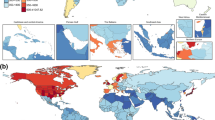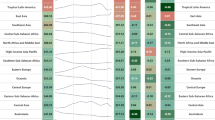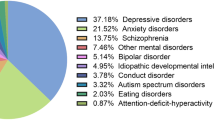Abstract
Autism spectrum disorders (ASD) is a lifelong neurodevelopmental condition that negatively affects older adults, yet it receives minimal priority and limited attention in research and healthcare services for this population. Using data from Global Burden of Diseases, Injuries, and Risk Factors Study 2021, we estimated the prevalence and disability-adjusted life-years (DALYs) of ASD among population aged ≥70 years globally from 1990–2021, with projections to 2040. Decomposition analysis was conducted. Globally, the number of ASD cases among individuals aged ≥70 years increased from 894.7 thousand in 1990 to 2478.9 thousand in 2021, corresponding to an increase of 177.1%, with population growth contributing to the largest increase, followed by increased age-specific prevalence rates. It is projected that by 2040, the number of cases will reach 5150.9 thousand worldwide, accounting for 864.7 thousand DALYs. Between 1990 and 2021, the prevalence rate of ASD among the older population increased by 13.2%, projecting to increase steadily by 2040. Males had a higher prevalence rate of ASD in 2021 (773.6 versus 287.8 per 100,000 people) than females. High sociodemographic index (SDI) countries had the highest rate and the greatest increase. Similar trend patterns were observed in the number of DALYs and DALY rates. To address this overlooked but increasingly severe challenge, more attention and timely development of effective interventions and management services are needed. High SDI countries should focus on developing effective intervention and treatment strategies, while middle and low SDI countries need to improve screening and diagnostic capacities and public awareness of ASD.
This is a preview of subscription content, access via your institution
Access options
Subscribe to this journal
Receive 12 print issues and online access
$259.00 per year
only $21.58 per issue
Buy this article
- Purchase on SpringerLink
- Instant access to full article PDF
Prices may be subject to local taxes which are calculated during checkout






Similar content being viewed by others
Data availability
The data used for the analyses in the study are publicly available at https://ghdx.healthdata.org/gbd-results-tool.
Code availability
Analysis code in R may be made available upon reasonable request by contacting the corresponding author.
References
Solmi M, Song M, Yon DK, Lee SW, Fombonne E, Kim MS, et al. Incidence, prevalence, and global burden of autism spectrum disorder from 1990–2019 across 204 countries. Mol Psychiatry. 2022;27:4172–80.
Robison JE. Autism prevalence and outcomes in older adults. Autism Res. 2019;12:370–4.
Lai MC, Lombardo MV, Baron-Cohen S. Autism. Lancet. 2014;383:896–910.
Piven J, Rabins P. Autism spectrum disorders in older adults: toward defining a research agenda. J Am Geriatr Soc. 2011;59:2151–5.
Mukaetova-Ladinska EB, Perry E, Baron M, Povey C. Ageing in people with autistic spectrum disorder. Int J Geriatr Psychiatry. 2012;27:109–18.
Mason D, Stewart GR, Capp SJ, Happé F. Older age autism research: a rapidly growing field, but still a long way to go. Autism Adulthood. 2022;4:164–72.
Shattuck PT, Garfield T, Roux AM, Rast JE, Anderson K, Hassrick EM, et al. Services for adults with autism spectrum disorder: a systems perspective. Curr Psychiatry Rep. 2020;22:13.
Fombonne E. Epidemiology of autistic disorder and other pervasive developmental disorders. J Clin Psychiatry. 2005;66(Suppl 10):3–8.
Brugha TS, McManus S, Bankart J, Scott F, Purdon S, Smith J, et al. Epidemiology of autism spectrum disorders in adults in the community in England. Arch Gen Psychiatry. 2011;68:459–65.
Rubenstein E, Tewolde S, Michals A, Fox M, Wang N. Prevalence of autism among medicaid-enrolled adults. JAMA Psychiatry. 2023;80:1284–7.
Dietz PM, Rose CE, McArthur D, Maenner M. National and State estimates of adults with autism spectrum disorder. J Autism Dev Disord. 2020;50:4258–66.
GBD 2021 Diseases and Injuries Collaborators. Global incidence, prevalence, years lived with disability (YLDs), disability-adjusted life-years (DALYs), and healthy life expectancy (HALE) for 371 diseases and injuries in 204 countries and territories and 811 subnational locations, 1990-2021: a systematic analysis for the Global Burden of Disease Study 2021. Lancet. 2024;403:2133–61.
GBD 2021 Causes of Death Collaborators. Global burden of 288 causes of death and life expectancy decomposition in 204 countries and territories and 811 subnational locations, 1990-2021: a systematic analysis for the Global Burden of Disease Study 2021. Lancet. 2024;403:2100–32.
Zigic N, Pajevic I, Hasanovic M, Avdibegovic E, Aljukic N, Hodzic V. Neurodevelopmental disorders in ICD-11 classification. Eur Psychiatry. 2023;66:S737.
American Psychiatric Association. Diagnostic and statistical manual of mental disorders: DSM-5™, 5th ed, text version. Washington, DC: American Psychiatric Association Publishing; 2013.
Harrison JE, Weber S, Jakob R, Chute CG. ICD-11: an international classification of diseases for the twenty-first century. BMC Med Inf Decis Mak. 2021;21:206.
Cheng X, Tan L, Gao Y, Yang Y, Schwebel DC, Hu G. A new method to attribute differences in total deaths between groups to population size, age structure and age-specific mortality rate. PLoS One. 2019;14:e0216613.
Cheng X, Yang Y, Schwebel DC, Liu Z, Li L, Cheng P, et al. Population ageing and mortality during 1990-2017: a global decomposition analysis. PLoS Med. 2020;17:e1003138.
Global Burden of Disease Study 2021 Autism Spectrum Collaborators. The global epidemiology and health burden of the autism spectrum: findings from the Global Burden of Disease Study 2021. Lancet Psychiatry. 2025;12:111–21.
Duchan E, Patel DR. Epidemiology of autism spectrum disorders. Pediatr Clin North Am. 2012;59:27–43. ix-x
King M, Bearman P. Diagnostic change and the increased prevalence of autism. Int J Epidemiol. 2009;38:1224–34.
Elsabbagh M, Divan G, Koh YJ, Kim YS, Kauchali S, Marcín C, et al. Global prevalence of autism and other pervasive developmental disorders. Autism Res. 2012;5:160–79.
Zeidan J, Fombonne E, Scorah J, Ibrahim A, Durkin MS, Saxena S, et al. Global prevalence of autism: a systematic review update. Autism Res. 2022;15:778–90.
Lyall K, Croen L, Daniels J, Fallin MD, Ladd-Acosta C, Lee BK, et al. The changing epidemiology of autism spectrum disorders. Annu Rev Public Health. 2017;38:81–102.
Newschaffer CJ, Croen LA, Daniels J, Giarelli E, Grether JK, Levy SE, et al. The epidemiology of autism spectrum disorders. Annu Rev Public Health. 2007;28:235–58.
Matson JL, Kozlowski AM. The increasing prevalence of autism spectrum disorders. Res Autism Spectr Disord. 2011;5:418–25.
The World Bank. Population ages 65 and above, total - Global. 2024. https://data.worldbank.org/indicator/SP.POP.65UP.TO?end=2023&start=1990. Accessed 22 Aug 2024.
The World Bank. Population ages 65 and above (% of total population) - Global. 2024. https://data.worldbank.org/indicator/SP.POP.65UP.TO.ZS?end=2023&start=1990. Accessed 22 Aug 2024.
The United Nations. World social report 2023: leaving no one behind in an ageing world. 2024. https://www.un.org/development/desa/dspd/wp-content/uploads/sites/22/2023/01/WSR_2023_Chapter_Key_Messages.pdf. Accessed 22 Aug 2024.
Woolfenden S, Sarkozy V, Ridley G, Coory M, Williams K. A systematic review of two outcomes in autism spectrum disorder - epilepsy and mortality. Dev Med Child Neurol. 2012;54:306–12.
Hirvikoski T, Mittendorfer-Rutz E, Boman M, Larsson H, Lichtenstein P, Bölte S. Premature mortality in autism spectrum disorder. Br J Psychiatry. 2016;208:232–8.
Hertz-Picciotto I, Delwiche L. The rise in autism and the role of age at diagnosis. Epidemiology. 2009;20:84–90.
Kim JY, Son MJ, Son CY, Radua J, Eisenhut M, Gressier F, et al. Environmental risk factors and biomarkers for autism spectrum disorder: an umbrella review of the evidence. Lancet Psychiatry. 2019;6:590–600.
Arango C, Dragioti E, Solmi M, Cortese S, Domschke K, Murray RM, et al. Risk and protective factors for mental disorders beyond genetics: an evidence-based atlas. World Psychiatry. 2021;20:417–36.
Rai D, Lee BK, Dalman C, Newschaffer C, Lewis G, Magnusson C. Antidepressants during pregnancy and autism in offspring: population based cohort study. BMJ. 2017;358:j2811.
Rai D, Lee BK, Dalman C, Golding J, Lewis G, Magnusson C. Parental depression, maternal antidepressant use during pregnancy, and risk of autism spectrum disorders: population based case-control study. BMJ. 2013;346:f2059.
von Ehrenstein OS, Ling C, Cui X, Cockburn M, Park AS, Yu F, et al. Prenatal and infant exposure to ambient pesticides and autism spectrum disorder in children: population based case-control study. BMJ. 2019;364:l962.
Sandin S, Schendel D, Magnusson P, Hultman C, Surén P, Susser E, et al. Autism risk associated with parental age and with increasing difference in age between the parents. Mol Psychiatry. 2016;21:693–700.
Bornstein E, Eliner Y, Chervenak FA, Grünebaum A. Concerning trends in maternal risk factors in the United States: 1989–2018. EClinicalMedicine. 2020;29-30:100657.
Hansen SN, Schendel DE, Parner ET. Explaining the increase in the prevalence of autism spectrum disorders: the proportion attributable to changes in reporting practices. JAMA Pediatr. 2015;169:56–62.
Lord C, Brugha TS, Charman T, Cusack J, Dumas G, Frazier T, et al. Autism spectrum disorder. Nat Rev Dis Primers. 2020;6:5.
Werling DM, Geschwind DH. Sex differences in autism spectrum disorders. Curr Opin Neurol. 2013;26:146–53.
Ferri SL, Abel T, Brodkin ES. Sex Differences in Autism Spectrum Disorder: a Review. Curr Psychiatry Rep. 2018;20:9.
Zhang Y, Li N, Li C, Zhang Z, Teng H, Wang Y, et al. Genetic evidence of gender difference in autism spectrum disorder supports the female-protective effect. Transl Psychiatry. 2020;10:4.
Muscatello RA, Rafatjoo E, Mirpuri KK, Kim A, Vandekar S, Corbett BA. Salivary testosterone in male and female youth with and without autism spectrum disorder: considerations of development, sex, and diagnosis. Mol Autism. 2022;13:37.
Wigdor EM, Weiner DJ, Grove J, Fu JM, Thompson WK, Carey CE, et al. The female protective effect against autism spectrum disorder. Cell Genom. 2022;2:100134.
Beggiato A, Peyre H, Maruani A, Scheid I, Rastam M, Amsellem F, et al. Gender differences in autism spectrum disorders: divergence among specific core symptoms. Autism Res. 2017;10:680–9.
Lai MC, Szatmari P. Sex and gender impacts on the behavioural presentation and recognition of autism. Curr Opin Psychiatry. 2020;33:117–23.
Durkin MS, Maenner MJ, Meaney FJ, Levy SE, DiGuiseppi C, Nicholas JS, et al. Socioeconomic inequality in the prevalence of autism spectrum disorder: evidence from a U.S. cross-sectional study. PLoS One. 2010;5:e11551.
Thomas P, Zahorodny W, Peng B, Kim S, Jani N, Halperin W, et al. The association of autism diagnosis with socioeconomic status. Autism. 2012;16:201–13.
Durkin MS, Maenner MJ, Baio J, Christensen D, Daniels J, Fitzgerald R, et al. Autism spectrum disorder among US children (2002-10): socioeconomic, racial, and ethnic disparities. Am J Public Health. 2017;107:1818–26.
Bhasin TK, Schendel D. Sociodemographic risk factors for autism in a US metropolitan area. J Autism Dev Disord. 2007;37:667–77.
Adak B, Halder S. Systematic review on prevalence for autism spectrum disorder with respect to gender and socio-economic status. J Ment Disord Treat. 2017;3:1–9.
Johnson CP, Myers SM. Identification and evaluation of children with autism spectrum disorders. Pediatrics. 2007;120:1183–215.
Liu J, Yang F, Liu M. Screening and services for autism among children in China. Lancet Psychiatry. 2022;9:e53.
Bölte S, Girdler S, Marschik PB. The contribution of environmental exposure to the etiology of autism spectrum disorder. Cell Mol Life Sci. 2019;76:1275–1297.
Funding
This study is funded by Harbin Medical University Leading Talent Grant (31021220002). The funder of the study was not involved in the study design, data collection, analysis, interpretation, or report writing.
Author information
Authors and Affiliations
Contributions
WT, GY, PY and MT conceptualized the study. WT and GY coded the statistical analysis, tables, figures, and supplementary, and drafted the manuscript. WT, GY, JZ and PY were involved in the interpretation of the data. XZ, JZ, WZ, YZZ, TL, PY and MT provided critical comments on drafts of the manuscript and revised the manuscript. YFZ and DS checked the data and results. JP, PY and MT had access to and verified the underlying study data. MT obtained funding. GY, PY and MT contributed equally are guarantors for this study. All authors participated in the review of the manuscript and read and approved the final manuscript. All authors had access to the data in the study and had final responsibility to submit for publication.
Corresponding authors
Ethics declarations
Competing interests
The authors declare no competing interests.
Ethics approval and consent to participate
Not applicable. This study did not involve human participants, personal data, or any form of intervention. All data utilized are publicly available, with access links provided in the manuscript.
Additional information
Publisher’s note Springer Nature remains neutral with regard to jurisdictional claims in published maps and institutional affiliations.
Supplementary information
Rights and permissions
Springer Nature or its licensor (e.g. a society or other partner) holds exclusive rights to this article under a publishing agreement with the author(s) or other rightsholder(s); author self-archiving of the accepted manuscript version of this article is solely governed by the terms of such publishing agreement and applicable law.
About this article
Cite this article
Tian, W., Yan, G., Zhang, X. et al. Global burden of autism spectrum disorders among population aged 70 years and older from 1990–2021, with projections to 2040: findings from the Global Burden of Disease Study 2021. Mol Psychiatry (2025). https://doi.org/10.1038/s41380-025-03172-0
Received:
Revised:
Accepted:
Published:
DOI: https://doi.org/10.1038/s41380-025-03172-0



